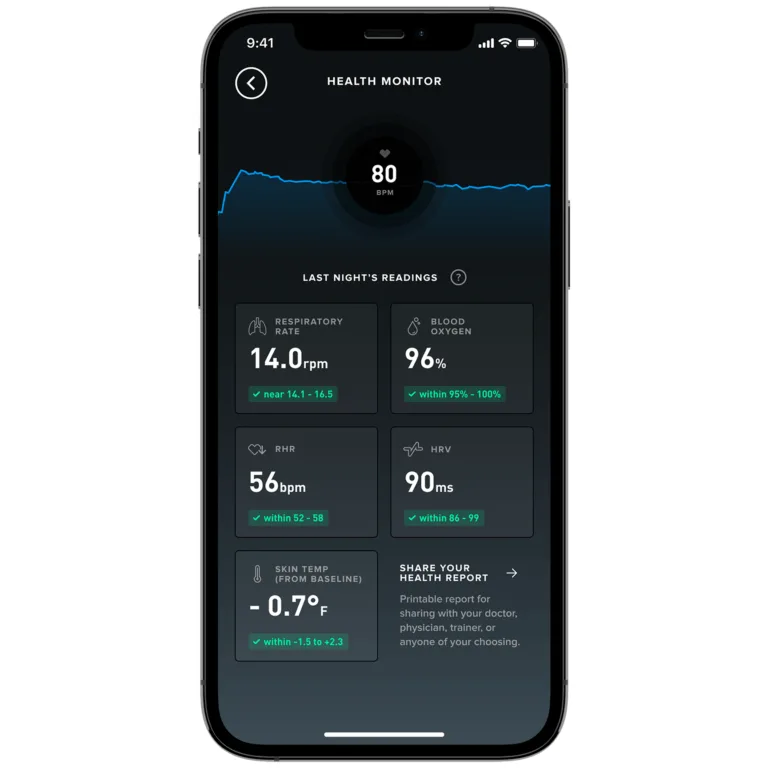Topics
- Article
- Respiratory Rate
Understanding Respiratory Rate: What it Is, What's Normal & Why You Should Track It

What is Respiratory Rate?
Your respiratory rate, often referred to as your breathing rate, is the number of breaths you take per minute. For most healthy adults, average breaths per minute typically range from 12 to 20 while in a state of rest. With the recent wave of the Omicron variant of COVID-19, respiratory rate remains an important vital sign to keep in mind. An increased respiratory rate may be a sign of illness. Each breath, or respiration, has two phases, inhalation and exhalation. Oxygen is brought into your lungs during inhalation, and transported throughout your body in the bloodstream. Carbon dioxide is then eliminated and dispersed from your lungs during exhalation.
Normal Respiratory Rate While Sleeping
WHOOP measures respiratory rate during sleep and reports it in units of “respirations per minute,” or RPM. The number you see displayed in the app is your average number of RPM over the course of the night while you are sleeping.

A one-week sample of all WHOOP members' respiratory rates, with the norm ranging from roughly 13-18 breaths per minute.
As you can see above, the majority of WHOOP members have an average respiratory rate that falls somewhere between 13 and 18 breaths per minute.

A chart depicting ranges for normal respiratory rate by age.
Why Monitoring Respiratory Rate Is So Important
WHOOP has actually tracked respiratory rate during sleep for a long time. We use minute-by-minute alterations in respiratory rate in our sleep staging algorithm because respiratory rate predictably changes slightly during different sleep stages. Initially, WHOOP didn’t display your average respiratory rate because it generally follows a similar trend as heart rate variability (HRV) and resting heart rate (RHR), so we weren’t sure how our members could use this information.

WHOOP tracks your respiratory rate while you sleep, and uses it to help calculate your daily Recovery.
However, in an effort to always improve the analysis and recommendations we provide, we discovered something interesting: While it is true that respiratory rate for adults is generally an indicator of cardiovascular fitness and load and therefore increases when RHR increases and decreases when RHR decreases, it is also a remarkably stable metric. From night to night, you should not expect to see much change in your respiratory rate statistic. But when it does change, that change tends to be meaningful.
What a High Respiratory Rate May Mean
While HRV and resting heart rate may meaninglessly change from day to day, respiration rate generally does not. In statistics, this is known as the “signal to noise ratio,” and it determines how much variance you need to confidently conclude that a change is significant as opposed to random. Median respiratory rate has an extremely high signal to noise ratio, which makes it very easy to interpret and trust. Because of this, respiratory rate is useful for spotting sleeps in which something is off (in particular, increases in respiratory rate). In my own data, for example, over a 30-day span my respiratory rate ranged from 14-15 breaths per minute every night except one--when I was sleeping in a middle seat on a red-eye plane from Boston to Reykjavik. My respiratory rate was 17 that night, and I slept terribly. Learn More: WHOOP Recovery Now Factors in Respiratory Rate Learn More: What Causes an Increased Respiratory Rate? Learn More: Leveraging WHOOP to Predict Risk of COVID-19 Using Respiratory Rate Learn More: Case Studies in Respiratory Rate in Time of COVID-19: How WHOOP Members are Using Their Data
How Does WHOOP Measure Respiratory Rate?
WHOOP calculates respiratory rate from your raw heart rate data by taking advantage of a phenomenon called Respiratory Sinus Arrhythmia. Here's how it works: When you breathe in your heart rate increases, and when you breathe out it decreases. This allows your body to preferentially pass blood by the lungs while they are full of oxygen. Because the autonomic nervous systems increase heart rate during inhalation and decrease it during exhalation, we can see respiratory rate in your continuous heart rate data by looking for this cyclical pattern of increasing and decreasing. WHOOP is the first wrist-worn wearable device to have the accuracy of its respiratory rate measurement during sleep validated by a third party. In a study published in the Journal of Clinical Sleep Medicine, WHOOP respiratory rate was shown to be within a single breath per minute of gold-standard truth.
Respiratory Rate & Other Vitals In WHOOP Health Monitor
The WHOOP Health Monitor feature tracks your respiratory rate and several other key vital signs (including live heart rate, HRV, resting heart rate, blood oxygen level, and skin temperature) and displays them all in one place. Every morning, the Health Monitor lets you know if each of these stats is within your typical range, color coding them in green, orange, or red.

The WHOOP Health Monitor displays your respiratory rate and other valuable physiological metrics.
The products and services of WHOOP are not medical devices, are not intended to diagnose COVID-19, the flu or any other disease or medical conditions, and should not be used as a substitute for professional medical advice, diagnosis or treatment. All content available through the products and services of WHOOP is for general informational purposes only.